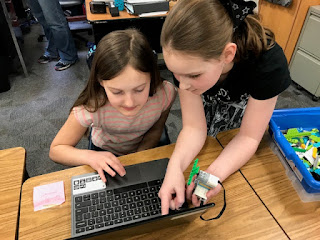Starting in September 2018, students in grades 3-12 will have access to 1:1 technology on a daily basis to support their individual learning. Students in grades PreK-2 are use technology in purposeful areas, with all classrooms having access to mobile devices when and where it can add to a lesson. The growth in technology, devices and support is part of the focus our community helped identify during strategic planning to ensure we are providing students with relevant and personalized learning opportunities.
The supports to develop digital-age learners continue to grow as our interactions with technology on a day-to-day basis has become more universal. The ability to navigate a website and the ads embedded in order to find information to solve a problem is a skill necessary at any age level today. For example, many regional news websites rely on advertisements to fund the writing, publishing, hosting and maintenance of their work so that it can be available to the public online. If you want to catch up on current events, you need to know how to navigate the network of ads across the site to find the information you want. Think of how student evidence of learning for this seventh-grade English standard in Minnesota has changed with online news sources, “...Evaluate a speaker’s point of view, reasoning, and use of evidence and rhetoric.” Anyone can publish a blog or story about events and it is up to you as the reader to decipher the intent and meaning based on the viewpoint of the author.
While that example highlights one of the skills necessary to consume information online today, harnessing each student’s ability to create, communicate, design, test and expand their understanding of content is where technology creates great opportunities. As digital learning grows, our classrooms will continue to focus on moving beyond basic consumption of information. With the basic recall of facts and figures at our fingertips, we can start to leverage our technology across PreK-12 to help students analyze content and create their own ideas using a variety of digital tools. The possibilities for individual student learning within our schools continues to grow along with the technology. It is exciting to see our students use technology too.
The supports to develop digital-age learners continue to grow as our interactions with technology on a day-to-day basis has become more universal. The ability to navigate a website and the ads embedded in order to find information to solve a problem is a skill necessary at any age level today. For example, many regional news websites rely on advertisements to fund the writing, publishing, hosting and maintenance of their work so that it can be available to the public online. If you want to catch up on current events, you need to know how to navigate the network of ads across the site to find the information you want. Think of how student evidence of learning for this seventh-grade English standard in Minnesota has changed with online news sources, “...Evaluate a speaker’s point of view, reasoning, and use of evidence and rhetoric.” Anyone can publish a blog or story about events and it is up to you as the reader to decipher the intent and meaning based on the viewpoint of the author.
While that example highlights one of the skills necessary to consume information online today, harnessing each student’s ability to create, communicate, design, test and expand their understanding of content is where technology creates great opportunities. As digital learning grows, our classrooms will continue to focus on moving beyond basic consumption of information. With the basic recall of facts and figures at our fingertips, we can start to leverage our technology across PreK-12 to help students analyze content and create their own ideas using a variety of digital tools. The possibilities for individual student learning within our schools continues to grow along with the technology. It is exciting to see our students use technology too.
Photos from a @MrsJBurling from Lego WeDo lesson.


Comments
Post a Comment